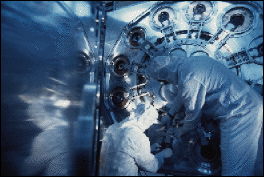Photonics Meets Computer Disk Challenge
Kate LeggettSAN JOSE, Calif. -- The demand for increasing data storage seems limitless. In the commercial world, voice mail, replicated databases and faxes on demand are fueling this need. In the consumer world, it is the virtual world of the Internet becoming a reality for millions, digital TV and multimedia games that are driving the demand up and the price point down.

Balzers' thin-film sputtering system offers color correction for specific applications. |
Again this year, disk drive manufacturers and their suppliers are in a race to deliver more data capacity in smaller spaces. The industry faces many challenges as it tries to meet a goal of 10 Gb/in.2 by 2000. These challenges come from the need for technologies that produce smaller bit sizes, lower magnetic head fly heights and smoother disk surfaces.
TeraStor of San Jose has found a way to use a solid immersion lens on a flying head to tightly focus a laser beam past its diffraction limit. This produces an ultrasmall spot size for data recording, thus reducing the magnetic bit cell size and increasing the data density tenfold.
Companies are also changing the way they manufacture disk drive components. Process control no longer depends on the periodic examination of the final product. Each part has to be inspected throughout the process.
To illustrate, the capability of the magnetic recording heads to read and write signals onto hard disks determines the overall storage capacity. More than 15 thin-film layers compose the head, any of which could contain defects.
Diskcon '97, the 11th annual exhibition for the data storage industry, focused on these issues. Between Sept. 22 and 26, a record-breaking 12,988 registrants attended the show, learning from the work of 419 exhibitors in 814 booths.
Highlights included:
LATEST NEWS
- AmeriCOM Adds President and CEO: People in the News: 5/1/24 May 1, 2024
- Machine Learning Pushes High-Power Lasing Limits May 1, 2024
- IPG Names Industry Veteran Mark Gitin CEO Apr 30, 2024
- 16th Biannual Optatec Conference Continues in Frankfurt Apr 30, 2024
- Celestial Surface Mapping Tech Combines Established Techniques Apr 30, 2024
- TSMC Partnerships Target Integrated Photonics Capabilities Apr 30, 2024
- CLEO Heads to the East Coast Apr 29, 2024
- Qubits Could be Stored in Flash-Like Memory Apr 29, 2024
